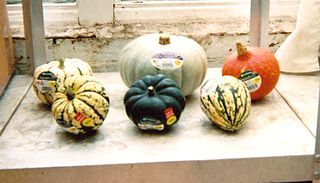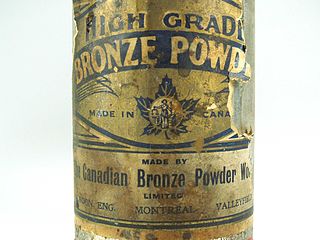Related Research Articles
Sales promotion is one of the elements of the promotional mix. The primary elements in the promotional mix are advertising, personal selling, direct marketing and publicity/public relations. Sales promotion uses both media and non-media marketing communications for a pre-determined, limited time to increase consumer demand, stimulate market demand or improve product availability. Examples include contests, coupons, freebies, loss leaders, point of purchase displays, premiums, prizes, product samples, and rebates.

Pricing is the process whereby a business sets the price at which it will sell its products and services, and may be part of the business's marketing plan. In setting prices, the business will take into account the price at which it could acquire the goods, the manufacturing cost, the marketplace, competition, market condition, brand, and quality of product.
In marketing, brand management begins with an analysis on how a brand is currently perceived in the market, proceeds to planning how the brand should be perceived if it is to achieve its objectives and continues with ensuring that the brand is perceived as planned and secures its objectives. Developing a good relationship with target markets is essential for brand management. Tangible elements of brand management include the product itself; its look, price, and packaging, etc. The intangible elements are the experiences that the target markets share with the brand, and also the relationships they have with the brand. A brand manager would oversee all aspects of the consumer's brand association as well as relationships with members of the supply chain.

Greenwashing, also called "green sheen", is a form of advertising or marketing spin in which green PR and green marketing are deceptively used to persuade the public that an organization's products, aims and policies are environmentally friendly. Companies that intentionally take up greenwashing communication strategies often do so in order to distance themselves from their own environmental lapses or those of their suppliers.

Organic certification is a certification process for producers of organic food and other organic agricultural products, in the European Union more commonly known as ecological or biological products. In general, any business directly involved in food production can be certified, including seed suppliers, farmers, food processors, retailers and restaurants. A lesser known counterpart is certification for organic textiles that includes certification of textile products made from organically grown fibres.

Consumer behaviour is the study of individuals, groups, or organisations and all the activities associated with the purchase, use and disposal of goods and services. Consumer behaviour consists of how the consumer's emotions, attitudes, and preferences affect buying behaviour. Consumer behaviour emerged in the 1940–1950s as a distinct sub-discipline of marketing, but has become an interdisciplinary social science that blends elements from psychology, sociology, social anthropology, anthropology, ethnography, ethnology, marketing, and economics.

The textile industry is primarily concerned with the design, production and distribution of textiles: yarn, cloth and clothing. The raw material may be natural, or synthetic using products of the chemical industry.

A Made in USA mark is a country of origin label affixed to homegrown, American-made products that indicates the product is "all or virtually all" domestically produced, manufactured and assembled in the United States of America. The label is regulated by the Federal Trade Commission (FTC).

Country of origin (CO) represents the country or countries of manufacture, production, design, or brand origin where an article or product comes from. For multinational brands, CO may include multiple countries within the value-creation process.
Xenocentrism is the preference for the cultural practices of other cultures and societies, such as how they live and what they eat, rather than of one's own social way of life. One example is the romanticization of the noble savage in the 18th-century primitivism movement in European art, philosophy and ethnography. Xenocentrism contrasts with ethnocentrism, the perceived superiority of one's own society to others.
Brand extension or brand stretching is a marketing strategy in which a firm marketing a product with a well-developed image uses the same brand name in a different product category. The new product is called a spin-off.

Fast fashion is the business model of replicating recent catwalk trends and high-fashion designs, mass-producing them at a low cost, and bringing them to retail stores quickly while demand is at its highest. The term fast fashion is also used generically to describe the products of the fast fashion business model.

Food marketing brings together the food producer and the consumer through a chain of marketing activities.
Consumer ethnocentrism is a psychological concept that describes how consumers purchase products based on country of origin.

Sustainable fashion is a term describing products, processes, activities, and people that aim to achieve a carbon-neutral fashion industry built on equality, social justice, animal welfare, and ecological integrity. Sustainable fashion concerns more than fashion textiles or products, rather addressing the entire process in which clothing is produced, consumed and disposed of. The movement looks to combat the large carbon footprint that the fast fashion industry has created by reducing the environmental impact such as air pollution, water pollution and climate change.

A brand is a name, term, design, symbol or any other feature that distinguishes one seller's good or service from those of other sellers. Brands are used in business, marketing, and advertising for recognition and, importantly, to create and store value as brand equity for the object identified, to the benefit of the brand's customers, its owners and shareholders. Brand names are sometimes distinguished from generic or store brands.

Cotton recycling is the process of converting cotton fabric into fibers that can be reused into other textile products.

Made in Canada and Product of Canada are certification marks designating a claim that Canada is the country of origin of a good. A product label for that good may use these marks, or a qualified version, to present that claim to consumers. The certification marks are voluntary within Canada but may be required on exported goods, to comply with the laws of the country of export.

Textile Fiber Products Identification Act is a consumer protection act in the United States. The act protects the interest of producers and consumers by imposing regulations of labelling and advertising of textile products. The act specifies labeling requirements and numerous guidelines for the advertising of textile products that should qualify the compliance in accordance with the directions in the act. The Federal Trade Commission considers any form of misbranding to be illegal. Moreover, it also requires that the commission provide a generic name for each man-made fibre, in particular for those not yet named. "Natural" and "manufactured" fibers were among two major groups classified by the act, which also maintains a list of generic names that is updated with each new entrant.
The Wool Products Labeling Act is a U.S. regulation enacted in 1939, which makes provisions for the accurate labeling of products containing wool fibers. The purpose of this act is to promote transparency and safeguard consumers and stakeholders in the wool industry from deceptive practices and false information regarding the composition of wool products in the market.
References
- ↑ Cai, Yi (2002). Country-Of-Origin Effects on Consumers' Willingness to Buy Foreign Products: An Experiment in Consumer Decision Making (PDF) (Master's thesis). The University of Georgia. Archived from the original on 2014-05-09.
- ↑ Johnson, Zachary S.; Tian, Yichao; Lee, Sangwon (2016). "Country-of-origin fit: When does a discrepancy between brand origin and country of manufacture reduce consumers' product evaluations?". Journal of Brand Management. 23 (4): 403–418. doi:10.1057/bm.2016.13. S2CID 167886281.
- ↑ Keith, Dinnie (2003). "Country-of-Origin 1965-2004: A Literature Review" (PDF). Brand Horizons. Archived (PDF) from the original on 12 October 2013. Retrieved 5 October 2013.[ self-published source? ]
- 1 2 3 Rayasam, Renuka (3 September 2013). "What does the "made in" label mean anymore?". New Yorker. Archived from the original on 12 October 2013. Retrieved 5 October 2013.
- 1 2 3 4 5 Hinkelman, E., & Shippey, K. (2004). Commodity Index. In Importers Manual USA: The Single Source Encyclopedia for Importing to the United States. (4th ed., pp. 763-764). Novato, California: World Trade Press.
- 1 2 3 Ward, P. (1986). Other Laws for Which the FTC has Enforcement Responsibilities. In Federal Trade Commission: Law, Practice and Procedure. New York, New York: Law Journal Press.
- ↑ Howard, Caroline. "On Fashion Revolution Day, Ask The Important Question: Who Made My Clothes?". Forbes. Retrieved 2023-07-13.
- ↑ Solca, L. (2015, June 14). The 'Made In' Dilemma: To Label, or Not to Label. Retrieved September 20, 2015, from http://www.businessoffashion.com/articles/opinion/the-made-in-dilemma-to-label-or-not-to-label
- ↑ Herz, Marc Florian; Diamantopoulos, Adamantios (2013). "Activation of country stereotypes: automaticity, consonance, and impact". Journal of the Academy of Marketing Science. 41 (4): 400–417. doi:10.1007/s11747-012-0318-1. S2CID 143296614.
- ↑ Saridakis, Charalampos; Baltas, George (2016). "Modeling price-related consequences of the brand origin cue: An empirical examination of the automobile market" (PDF). Marketing Letters. 27 (1): 77–87. doi:10.1007/s11002-014-9304-3. S2CID 59431918.
- 1 2 Günter Schweiger; Thomas Otter; Andreas Strebinger. "The influence of country of origin and brand on product evaluation and the implications thereof for location decisions" (PDF). Institut für Werbewissenschaft und Marktforschung. Archived from the original (PDF) on 2013-10-12.
- ↑ Jain, Subhash C. (2012). Handbook of Research in International Marketing, Second Edition (Elgar Original Reference). Edward Elgar Publishing. p. 467. ISBN 978-1849803021.
- ↑ Aiello, G., Donvito, R., Godey, B., Pederzoli, D., Wiedmann, K.-P., Hennings, N., Siebels, A., Chan, P., Tsuchiya, J., Rabino, S., Ivanovna, S. I., Weitz, B., Oh, H., & Singh, R. 2008. An International Perspective on Luxury Brand and Country-of-Origin Effect. Brand Management, 16(5/6): 323-337.
- ↑ Sigitas Urbonavičius; Justina Gineikienė (2009). "Importance of the Product Country-of-Origin Factor on Purchasing Process in the Context of Globalisation" (PDF). Ekonomika: 41. Archived from the original (PDF) on 2013-10-07.
- 1 2 3 4 Durairaj Maheswaran; Cathy Chen Yi (February 2008). "Nation Equity: Country-of Origin Effects and Globalization" (PDF). Nation Equity Research. Archived from the original (PDF) on 12 October 2013. Retrieved 5 October 2013.
- 1 2 Olsson, Karin (1 June 2012). "Brand gap and the effect of country-of-origin: A consumer survey in Rhone-Alps" (PDF). School of Sustainable Development of Society and Technology, Mälardalen University. Archived (PDF) from the original on 10 June 2015. Retrieved 6 October 2013.
- ↑ Sertan Kabadayi; Dawn Lerman. "Made in China but Sold at Fao Schwarz: Country of Origin Effect and Trusting Beliefs" (PDF). Programme Mémoire Vivante.[ permanent dead link ][ clarification needed ]
- ↑ Oberecker, E. M., Riefler, P., & Diamantopoulos, A. 2008. The Consumer Affinity Construct: Conceptualization, Qualitative Investigation, and Research Agenda. Journal of International Marketing, 16(3): 23-56.
- ↑ Klein, J. G., Ettenson, R., & Morris, M. D. 1998. The Animosity Model of Foreign Product Purchase: An Empirical Test in the People's Republic of China. Journal of Marketing, 62(1): 89-100.
- ↑ Shimp, T. A. & Sharma, S. 1987. Consumer Ethnocentrism: Construction and Validation of the CETSCALE. Journal of Marketing Research, 24(3): 280-289.
- ↑ Sankar, Shyamala Mathan (2006). Consumer Perception of Global vs. Local Brands: The Indian Car Industry (PDF) (Master's thesis). University of Nottingham. Archived from the original (PDF) on 2010-12-26.
- ↑ Benson, Joseph; Levinson, Rob; Allison, Drew (2006). "Brand Blueprint: CHINESE BRANDS ARE COMING TO AMERICA" (PDF). Brand Blueprint. Archived from the original (PDF) on 2015-06-10. Retrieved 2013-10-06.
- ↑ "Mattel to recall more Chinese-made toys". CNN. Archived from the original on 17 March 2020. Retrieved 14 August 2007.
- ↑ Spain withdraws Chinese toothpaste from the oral care market CosmesticsDesigns.com. 12 July 2007 Archived 26 September 2007 at the Wayback Machine .Accessed: 2007-09-05.
- ↑ Ramachandran, Arjun (29 August 2007). "Toxic toothpaste alert: buyers beware". The Sydney Morning Herald. Archived from the original on 21 September 2007. Retrieved 29 August 2007.
- ↑ "The Country of Origin Effect". The Economist. 4 August 2011. Archived from the original on 12 October 2013.
- ↑ Lumb, Ruth and Lall, Vinod (1 March 2006). "Perception of the quality of products made in India by consumers from the United States: a longitudinal analysis". Indian Journal of Economics and Business. Archived from the original on 3 February 2016. Retrieved 6 October 2013.
{{cite journal}}: CS1 maint: multiple names: authors list (link) - ↑ Peng, Mike W. (2013). Global Strategy. Cengage Publishing. p. 177. ISBN 978-1133964612.
- ↑ Peters, Nils (2013). The country-of-origin affect on perception of services: Entry mode decisions as a determinant of usability (Master's thesis). Grin Verlag Gmbh. p. 116. ISBN 978-3656020790.
- ↑ Aichner, T. 2014. Country-of-origin marketing: A list of typical strategies with examples. Journal of Brand Management, 21(1): 81-93.